The Bible
There is only one verse in the Bible which gives us a hint of where we the ark came to rest, "the ark rested...upon the mountains of Ararat." Genesis 8:4. Where is Ararat? The name Ararat is a large area or ancient country covering eastern Turkey, western Iran and western Russia, as shown in yellow below.
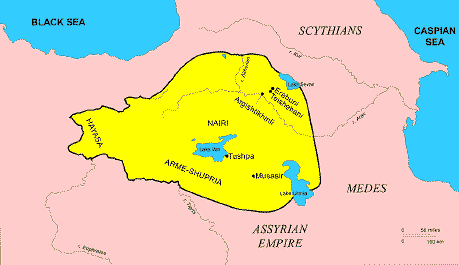
"The name Ararat, as it appears in the Bible, is the Hebrew equivalent of ...Urartu, ancient country of southwest Asia...mentioned in Assyrian sources from the early 13th century BC" Encyclopaedia Britanica 15th ed. Some have mistakenly assumed the Bible meant the ark came to rest on Mount Ararat (Agri Dagh), but that is not the case. Mount Ararat is 17,000 feet tall, and is a post-Flood volcanic mountain that gained its height after the Flood, therefore there is no reason to assume it is a more likely candidate for the resting place of the ark, instead it is a less likely candidate. The ark came to rest in the mountains of the ancient country of Urartu, not on Mt. Ararat.
The Ancient Historical Record
Flavius Josephus, c. 90 AD, the famous Jewish historian stated, "Its remains are shown there by the inhabitants to this day." He quotes Berosus the Chaldean, c. 290 BC, who indicated tourists would take home pieces of the ark for making good-luck charms, "It is said there is still some part of this ship in Armenia, at the mountain of the Cordyaeans; and that some people carry off pieces of the bitumen, which they take away, and use chiefly as amulets for the averting of mischiefs." These comments tend to indicate its location would not be in an inaccessible area. At some point, the ark was covered by a mud and lava flow which caused future generations to lose its location.
Life Magazine 1960
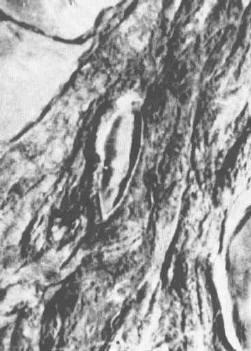
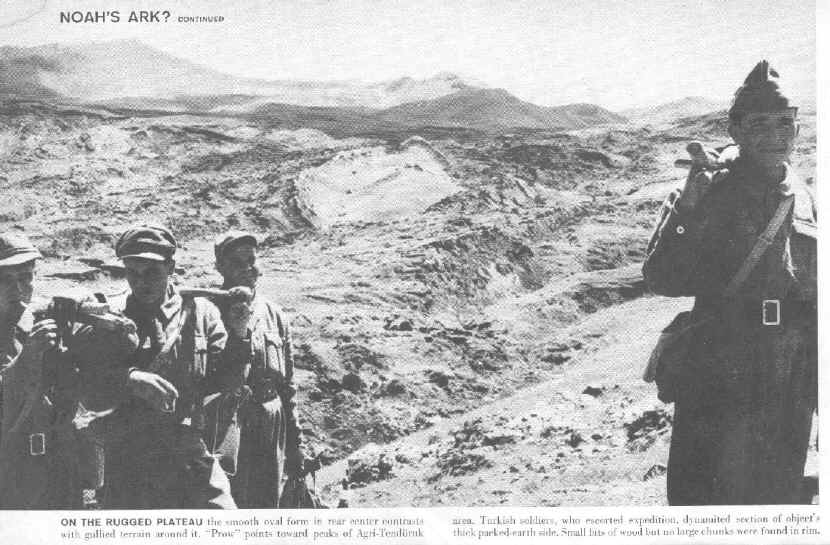
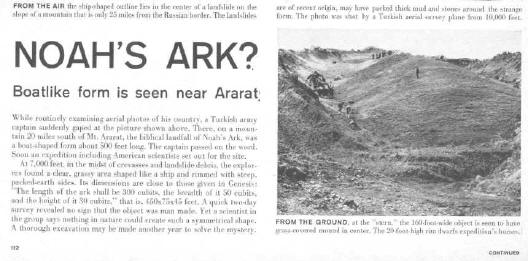
The 1960 expedition to the ark found a formation whose top sides were even with ground level as seen in the photos above. The site researched by Ron Wyatt is 18.2 miles south of Mount Ararat at the elevation of 6,524 ft., in the "mountains of Ararat." A Turkish captain, Llhan Durupinar, was reviewing NATO Geodetic Survey photographs of the area in 1959, and noticed a boat shaped formation. Others in the U.S. then analyzed the photograph including Dr. Arthur J. Brandenburger, world famous expert in photogrammetry, who said "I have no doubt at all that this object is a ship. In my entire career I have never seen an object like this on a stereo photo. Even the approximate length of the object fits" The Ark File, p118. An expedition sponsored by a party from the U.S. included among others, Rene Noorbergen, later author of The Ark File; and George Vandeman, evangelist, and Dr. Brandenburger. They made a visual inspection of the site and conducted no scientific studies, only some digging and dynamiting of the ark and and mistakenly concluded this site was just an "odd geological formation." The expedition was expecting to find on the surface of the ark "petrified beams" The Ark File, p126, by digging in a few places. An article then appeared in the September 5th, 1960, Life magazine, shown above, revealing a very impressive aerial photo of an extremely large boat-shaped object, plus two photos taken by the expedition. Seventeen years later in 1977, Mr. Wyatt made his first of 24 trips to the ark, and he was impressed that this really was the remains of Noah's Ark! In the research he performed over the next 15 years, Mr. Wyatt successfully performed metal detection tests and subsurface radar scans of the site, and he proved this site really IS the mud-and-lava covered remains of Noah's Ark!
Government Confirmation:
Visitors' Center Opened
The Turkish government has double-verified Mr. Wyatt's tests, and they have given him credit for the discovery. The announcement appeared in Turkey's largest newspaper on June 21, 1987. The area was first designated a National Park, and then it was upgraded to the status of a National Treasure. The government has built a visitors' center overlooking the site and issued official tourist brochures so people of all races can come and see the ark!
Above - visitors' center at Noah's Ark National Park which overlooks the ark site. (2002)
The Announcement of the Discovery
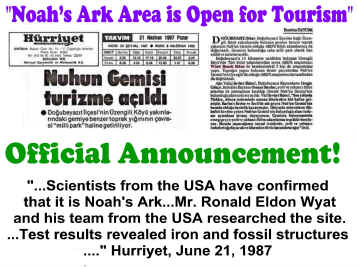
Translation of newspaper article announcing the discovery of Noah's Ark:
"THE NOAH'S ARK OPENED TO TOURISM. The surrounding area of a ship-like soil pile nearby the village of Uzengili within the township of Dogubeyazit as a national park. Dogubeyazit - The American Academians confirmed the soil pile nearby the village of Uzengili in the township of Dogubeyazit is Noah's Ark. The surrounding area is declared to be a national park and it is opened to tourism. 15 Km away from Dogubeyazit at the village of Uzengili, Ronal Eldon Wyatt and his colleagues, an American research group, made researches after their Turkish colleagues completed their investigations. Upon analyzing the soil structure and finding specific iron pieces and particles, the American researchers concluded that Noah's Ark is located at Uzengili village. With a ceremony attended by the Governor of Agri Province, Subgovernor of Dogubeyazit township, the Mayor Usha, Mr. Osman Baydar and the local and foreign scientists and researchers and a group of citizens, the Noah's Ark is opened to touristic visits. The Governor Serket Ekinci said, "In recent years, Turkey has become one of the countries to be visited in worldwide tourism. It is assured that the Noah's Ark, mentioned in Quran and the Bible, is located here. I am honored to pen this area having the Noah's Ark which attracts attentions of millions in the world. I owe our thanks to those national and foreign scientists and researchers contributed to the researches so as to locate Noah's Ark. At the social facilities to be built, we will accommodate local and foreign tourists and have our country make hard currency." translation courtesy Val Smith www.throneofgod.com
Government sign directs your way to the ark
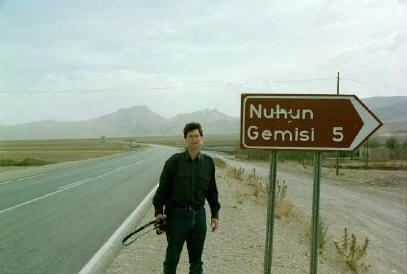
Kevin Fisher standing in the "Valley of Eight" along the main highway, this government sign points your way to "Noah's Big Boat." Behind me is the border with Iran just a short distance away. To my left and up on the mountain 5 Km away, lies Noah's pride and joy.
The Length Matches the Biblical Record!
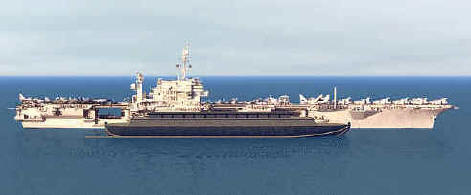
Noah's Ark at 515 feet compared to the U.S.S. Kitty Hawk aircraft carrier. Graphics Mark Johnson, ArkFind.com
The length of the ruins of the ark is 515 ft., which is exactly 300 Egyptian cubits (20.6 inches)! Moses was schooled in Egypt and was not familiar with the Hebrew cubit which was not even in existence when Moses wrote Genesis.

The brown material above represents the outline and shape of the ark today. The Bible said there were three levels, and based upon the present depth of the ark, it may have originally appeared as shown above. (diagram courtesy anchorstone.com)
Ark Excavated by God

Pre-earthquake photo
The photo above shows the ark deeply embedded in the surrounding terrain. In 1978, when Mr. Wyatt was returning to Nashville, he prayed that God would send an earthquake to "excavate" the site. When arriving in Nashville the headlines read, "Earthquake in Eastern Turkey." The earth dropped from around the sides of the ark, defining the formation more clearly and making it more accessible for research.
Metal Used in the Ark!
The ark contains a large amount of metal fittings used to secure the large timbers together. These two photos below are from our October 2000, trip to the site. Notice how there was once two large rivet fasteners, but now only one is left. A large metal plate was positioned behind the rivets. I received a positive metal reading when passing the metal detector over the rivets. We should not be surprised to find metal alloys used in the ark, because Genesis 4:22 states, "Tubal-Cain, an instructor of every craftsman in bronze and iron."
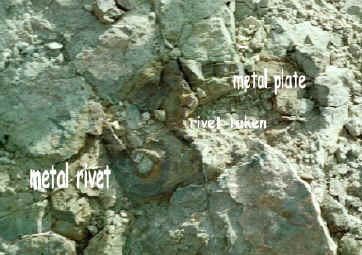
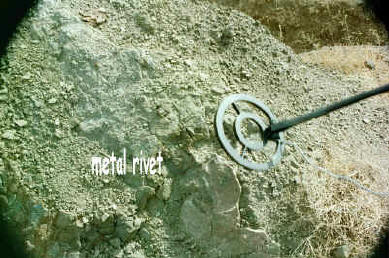
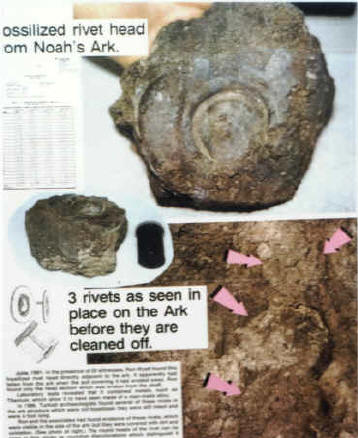
(Left) Ron Wyatt found a beautiful specimen of one of the metal rivets used on the ark. It was tested and found to contain high-tech metal alloys, such as titanium, magnesium, and aluminum, etc. Critics have said Ron did not find this fine specimen on the ark but just manufactured it. Well, as you will see below, we found the same objects and had them tested. They too proved to have the same metals, in the same percentages! (Below) Two rough rivets in lower portion of photo.
Our Own Metal Samples Tested
Lab Report Shows Fossilized Rivet Contains Man-Made Metals!
Below is what appears to be part of a large washer that would have been slipped over a shaft and then secured on the shaft by flaring out the end of the shaft. We have drawn circles on the photo to demonstrate the circular effect in the specimen. The surrounding material on the side of the ark around this object had a greenish color. Assuming a circular shape, this sample would be the same size as the rivet found by Mr. Wyatt. (The photo at right is of the rivet as we found it on the ark)
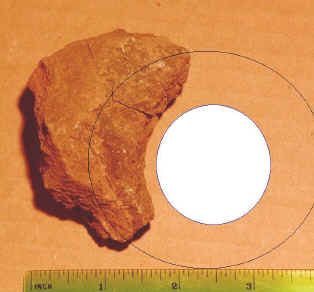
Galbraith Laboratories of Knoxville Tennessee has tested the specimen for three metals I requested. I asked them to test for aluminum metal, iron metal, and titanium metal. It costs $60 to test for each metal requested. The results show 8.35 % iron metal, 8.35% aluminum metal, and 1.59% titanium metal. ALUMINUM AND TITANIUM METALS ARE NOT FOUND IN NATURE!!! THIS OBJECT IS MAN-MADE, USING ADVANCED TECHNOLOGY!! These results are similar to those produced in the analysis of the rivet found by Mr. Wyatt. Since the specimen is fossilized, it is assumed a large portion of it is now silica replacement, reducing the percentage of metal that was originally in it when it was made. These rivets are found in several locations on the outside of the Ark, and are probably buried inside the Ark by the hundreds or thousands. In comparison to others, this specimen is in poor condition.
Second specimen is also man-made with aluminum metal!
This may be the end of a metal rod. Turkish officials reported removing four foot long metal rods from the site.
Metal Bracket
In May, 1985, Dr. John Baumgardner of Los Alomas Labs, was inspecting the ark with a metal detector when he became startled and said, "Undecomposed Iron!" A rectangular beam was protruding from the side of the ark, with iron flakes. He found a beautiful right angled wrought iron bracket which had been stretched and hammered, showing preferential gradiance. John tested it at Los Alomas Labs and it was found to be 91.84% iron FE203.
Ballast?
Below is a suspected piece of metal ballast that may have been thrown into the bottom of the ark when the craftsmen were through forming metal brackets and had metal waste left over. Notice the concave features on almost every side, where other pieces of ballast were pressed against it when it was still hot. I found this near the ark. (Two photos of same item.)
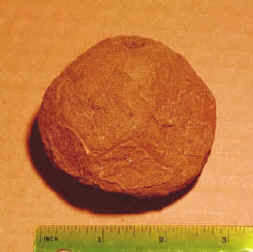
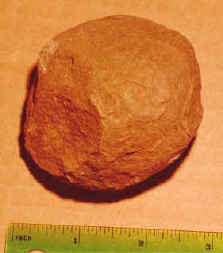
Metal Wedge?
This appears to be some manganese ballast which was poured into the hull in a liquid state,
then hardened and took the curvature of the hull (right photo). It has a coating on the convex side, while the flat side appears to be metal. Found a few feet away from the ark.
Ballast Found by Wyatt
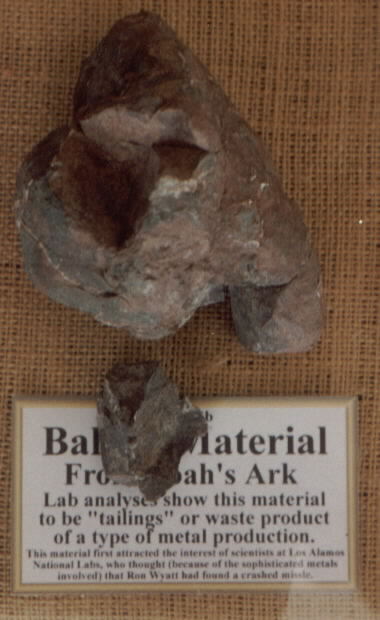
This is an example of the metal ballast that has been found in the hull of the ark. It is made up of manganese primarily, which is a by-product of forming magnesium that was used in the metal rivets. Found by Ron Wyatt.
Square Object with "X" Impression
The western side of the ark had this square object that had the appearance of metal on its top and three sides.. It also contained an impression in it, much like it had been struck while it was hot. It was at a higher level where I could not measure it. It may have been 8 inches in diameter.


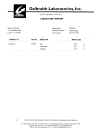
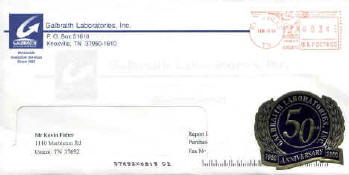
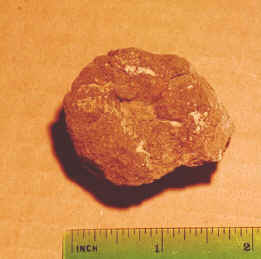
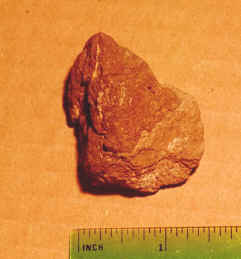
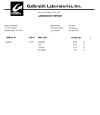

No comments:
Post a Comment